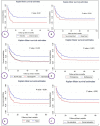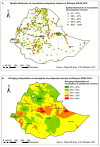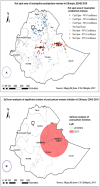Time to Resumption of Menses, Spatial Distribution, and Predictors Among Post-partum Period Women in Ethiopia, Evidence From Ethiopian Demographic and Health Survey 2016 Data: Gompertz Inverse Gaussian Shared Frailty Model
- PMID: 36303667
- PMCID: PMC9580771
- DOI: 10.3389/frph.2022.862693
Time to Resumption of Menses, Spatial Distribution, and Predictors Among Post-partum Period Women in Ethiopia, Evidence From Ethiopian Demographic and Health Survey 2016 Data: Gompertz Inverse Gaussian Shared Frailty Model
Abstract
Background: The timing of the resumption of post-partum menses is important for a woman who intends to avoid subsequent unintended pregnancy, and it has key implications on maternal, neonatal, and child health outcomes. Despite this, information is scant about the time to resumption of post-partum menses and predictors in Ethiopia. Therefore, this study aimed to determine the time it takes to start menses and spatial distribution among post-partum period women in Ethiopia and identify its predictors.
Methods: A secondary data analysis was conducted based on 2016 Ethiopian Demographic and Health Survey (EDHS). A total weighted sample of 6,489 post-partum women was included in the analysis. STATA 14 was used to weigh, clean, and analyze the data. The shared frailty model was applied since the EDHS data have a hierarchical nature. For checking the proportional hazard assumption, the Schenefold residual test, Log-Log plot, Kaplan-Meier, and predicted survival plot were applied. Akakie Information Criteria (AIC), Cox-Snell residual test, and deviance were used for checking model adequacy and for model comparison. Based on these, the Gompertz inverse Gaussian shared frailty model was the best-fitted model for this data. Variables with a p < 0.2 were considered for the multivariable Gompertz inverse Gaussian shared frailty model. Finally, the adjusted hazard ratio (AHR) with a 95% confidence interval (CI), and a p < 0.05 was reported to identify the significant predictors of time to the resumption of post-partum menses.
Results: The median survival time to post-partum menses resumption was 14.6 months. In this study, 51.90% [95% CI: 50.03, 53.76] of post-partum period women had resumed, and the risk of menses resumption was 1.17 times [AHR: 1.17; 95% CI: 1.03-1.33] higher among urban resident, 1.14 times [AHR: 1.14; 95% CI: 1.0-1.24] in women who had attended formal education, and 1.63 times [AHR: 1.63; 95% CI: 1.4-1.7] higher among women who used hormonal contraceptives. However, the risk of post-partum menses resumption was lower among 7-24 months breastfeeding women by 36% [AHR: 0.64; 95% CI: 0.5-0.76], women with child alive by 26% [AHR: 0.74; 95% CI: 0.6-0.85], and multiparous women by 27% [AHR: 0.73; 95% CI: 0.6-0.80].
Conclusion: Almost half of the participants had resumed post-partum menses, with the median survival timing of menses resumption at 14.5 months. Women residing in urban areas, who attended formal education, and using hormonal contraceptives have a shorter time to resume post-partum menses, whereas a woman with an alive child, breastfeeding practice, and multiple parity has a longer time to resume post-partum menses. Therefore, the healthcare providers and program managers should act on the resumption of post-partum menses through health education and promotion to cultivate the 14 months lag period identified by considering the significant factors.
Keywords: Ethiopia; Gompertz inverse Gaussian shared frailty; menses; post-partum; resumption.
Copyright © 2022 Belay and Asratie.
Conflict of interest statement
The authors declare that the research was conducted in the absence of any commercial or financial relationships that could be construed as a potential conflict of interest.
Figures




Similar articles
-
Incidence of neonatal mortality and its predictors among live births in Ethiopia: Gompertz gamma shared frailty model.Ital J Pediatr. 2020 Sep 21;46(1):138. doi: 10.1186/s13052-020-00893-6. Ital J Pediatr. 2020. PMID: 32958080 Free PMC article.
-
Predictors of early resumption of post-partum sexual intercourse among post-partum period women in Ethiopia: A multilevel analysis based on Ethiopian demographic and health survey 2016.PLoS One. 2022 Sep 9;17(9):e0271372. doi: 10.1371/journal.pone.0271372. eCollection 2022. PLoS One. 2022. PMID: 36084107 Free PMC article.
-
Time to initiation of antenatal care visit and its predictors among reproductive age women in Ethiopia: Gompertz inverse Gaussian shared frailty model.Front Glob Womens Health. 2023 Oct 3;4:917895. doi: 10.3389/fgwh.2023.917895. eCollection 2023. Front Glob Womens Health. 2023. PMID: 37854167 Free PMC article.
-
Duration of birth interval and its predictors among reproductive-age women in Ethiopia: Gompertz gamma shared frailty modeling.PLoS One. 2021 Feb 19;16(2):e0247091. doi: 10.1371/journal.pone.0247091. eCollection 2021. PLoS One. 2021. PMID: 33606724 Free PMC article.
-
Socio-demographic and antenatal care-related factors associated with early post-partum family planning use in Ethiopia: evidence from Ethiopian Demographic and Health Survey 2016 data.Front Glob Womens Health. 2023 Sep 1;4:1131143. doi: 10.3389/fgwh.2023.1131143. eCollection 2023. Front Glob Womens Health. 2023. PMID: 37727741 Free PMC article.
References
-
- Keith Edmonds D . Puerperium and Lactation, Dewhurst's Textbook of Obstetrics and Gynaecology. Dewhurst's Textbook of Obstetrics & Gynaecology. John Wiley & Sons. (2018).
LinkOut - more resources
Full Text Sources

